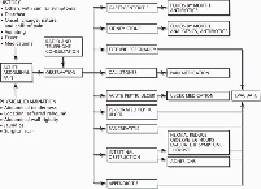Travel Reference
In-Depth Information
diaphragm and interferes with respiration; it also presses on the veins in the abdomen and
impedes the return of blood from the lower body to the heart.
In addition, large quantities of fluids—digestive juices, partially digested food, and oth-
er liquids that have been consumed—pool in the paralyzed stomach with the air, and even-
tuallyleadtovomiting.Lossofthefluidsandelectrolytes canproduceoraggravatedehyd-
ration, and pneumonia or respiratory obstruction may result if the vomitus is aspirated.
A tube inserted through the nose and esophagus into the stomach permits the air that is
swallowed to escape and prevents most of these problems. The tube is uncomfortable and
can cause a sore throat, but it usually does not cause gagging or related symptoms.
The use of nasogastric suction is not without hazard because fluids, as well as air, are
removed from the stomach. If these fluids are not replaced intravenously with a balanced
salt solution or saline, salt and water depletion inevitably result. If fluids for intravenous
therapy are not available, the nasogastric tube should be used only to remove air that has
collected. After the air has escaped, the tube should be clamped and only reopened when
significant quantities of air have reaccumulated.
Figure 20-4. Algorithm for diagnosing acute abdominal pain
The technique for nasogastric intubation is as follows:
1. The tube, at least a size 18 French, should have the tip lubricated with a bland jelly,
mineral oil, or at least water before it is inserted.
2. The person should be sitting up and should have cold water, crushed ice, or snow to
swallow. If available, lidocaine jelly can be applied to the nares, and the throat can be
sprayed with cetacaine to relieve discomfort during intubation and afterward.
3. The tube should be inserted through one nostril, horizontally along the floor of the
nasal cavity, to the back of the throat. Then the person should be instructed to swallow.
During swallowing, the tube should be thrust farther so the tongue and muscles of the
throatcanguideitintotheesophagus.Severalattemptsareusuallynecessary.Whenthe
tube does enter the esophagus the individual should be told to keep swallowing. With
eachswallowthetubeshouldbethrustfartherdownuntilalengthequaltothedistance

Search WWH ::

Custom Search